Click image for BBB rating
See our Privacy Policy
cool="cool" width="785" height="6625" border="0" cellpadding="0" cellspacing="0" gridx="16" showgridx="showgridx" usegridx="usegridx" gridy="16" showgridy="showgridy" usegridy="usegridy" bgcolor="#99ccff">
|
|
|
|
|
 |
|
|
|
|
|
|
|
|
|
Welcome to Spaightwood Galleries, Inc.
120 Main Street, Upton MA 01568-6193; 800-809-3343; email: spaightwood@gmail.com
Fernand Léger (French, 1881-1955)
Impressionist and Post-Impressionist Prints and Drawings: Prints by Pierre Bonnard, Georges Braque, Charles Camoin, Mary Cassatt, Paul Cezanne, Henri Edmond Cross, Edgar Degas, Sonia Delaunay, Maurice Denis, André Derain, Susanne Duchamp, Raoul Dufy, Jean-Louis Forain, Pauk Gauguin, Marie Laurencin, Fernand Léger, Edouard Manet, Henri Matisse, Berthé Morisot, Pablo Picasso, Pierre Auguste Renoir, Geeorges Rouault, Ker Xavier Roussel, Paul Signac, Henri Toulouse-Lautrec, Suzanne Valadon, Maurice de Vlaminck, James A. McNeill Whistler, and others.
Drawings by Albert Besnard, Andre Barbier, Henri Edmond Cross, Jean-Louis Forain, Eva Gonzales, Marie Laurencin, Maximilien Luce, and Georges Rouault.
Hand-colored prints by Mary Cassatt, Marc Chagall, Sonja Delaunay, Fernand Léger, Joan Miró, Henri Matisse, and Pablo Picasso.
For a review of the show that concludes, "Art exhibits in Madison rarely get this good," click review.
|
|
|
Léger was one of the most prominent artists of the first half of the twentieth century. Since his death, a number of mportant retrospectives (see selcct bibliography below), have given viewers a chance to get a better sense of his work. As Nicholas Serota observed, Léger's "favorite analytical tool, the pencil," was the starting point for "his relentless study of the single object in space" and his "obsession with volume, defined by light, shade, and contour," is one of the keys to understanding his work (p. 9). Another key (as George L. K. Morris remarks in his prefce to Léger's collected writings on art, The Function of Painting), is the machine: "Early in the twentieth century he detected a new civilization, with an accent of its own. Cézanne had maintained that a work of art should hold its own with nature. . . . Léger, of a later generation, insisted that it was with manufactured objects that a painting must now compete" (p. ix).
What follows is borrowed from the Wikipedia entry on Léger; for a longer introduction see Judi Freeman's entry on Léger in the Grove Dictionary of Art, vol. 19, 76-84). Léger was born in the Argentan, Orne, Basse-Normandie, where his father raised cattle. Fernand Léger initially trained as an architect from 1897-1899 before moving in 1900 to Paris, where he supported himself as an architectural draftsman. After military service in Versailles in 1902-1903, he enrolled at the School of Decorative Arts; he also applied to the Ecole des Beaux-Arts but was rejected. He nevertheless attended the Beaux-Arts as a non-enrolled student, spending what he described as "three empty and useless years" studying with Gérôme and others, while also studying at the Académie Julian. He began to work seriously as a painter only at the age of 25. At this point his work showed the influence of Impressionism, as seen in Le Jardin de ma mère (My Mother's Garden) of 1905, one of the few paintings from this period that he did not later destroy. A new emphasis on drawing and geometry appeared in Léger's work after he saw the Cézanne retrospective at the Salon d'Automne in 1907.
In 1909 he moved to Montparnasse and met such leaders of the avant-garde as Archipenko, Lipchitz, Chagall, and Robert Delaunay. His major painting of this period is Nudes in the Forest (1909-10), in which Léger displayed a personal form of Cubism—his critics called it "Tubism" for its emphasis on cylindrical forms—that made no use of the collage technique pioneered by Braque and Picasso. In 1910 he joined with several other artists, including Delaunay, Jacques Villon, Henri Le Fauconnier, Albert Gleizes, Francis Picabia, and Marie Laurencin to form an offshoot of the Cubist movement, the Puteaux Group—also called the Section d'Or (The Golden Section). Léger was influenced during this time by Italian Futurism, and his paintings, from then until 1914, became increasingly abstract. Their vocabulary of tubular, conical, and cubed forms are laconically rendered in rough patches of primary colours plus green, black and white, as seen in the series of paintings with the title Contrasting Forms.
Léger's experiences in World War I had a significant effect on his work. Mobilized in August 1914 for service in the French Army, he spent two years at the front in Argonne. He produced many sketches of cannons, airplanes, and fellow soldiers while in the trenches, and painted Soldier with a Pipe (1916) while on furlough. In September 1916 he almost died after a mustard gas attack by the German troops at Verdun. During a period of convalescence in Villepinte he painted The Card Players (1917), a canvas whose robot-like, monstrous figures reflect the ambivalence of his experience of war. This painting marked the beginning of his "mechanical period", during which the figures and objects he created were characterized by sleekly rendered tubular and machine-like forms. Starting in 1918, he also produced the first paintings in the Disk series, in which disks suggestive of traffic lights figure prominently. . . . The "mechanical" works Léger painted in the 1920s, in their formal clarity as well as in their subject matter—the mother and child, the female nude, figures in an ordered landscape—are typical of the postwar "return to order" in the arts, and link him to the tradition of French figurative painting represented by Poussin and Corot. In his paysages animés (animated landscapes) of 1921, figures and animals exist harmoniously in landscapes made up of streamlined forms. The frontal compositions, firm contours, and smoothly blended colors of these paintings frequently recall the works of Henri Rousseau, an artist Léger greatly admired and whom he had met in 1909.
Starting in 1927, the character of Léger's work gradually changed as organic and irregular forms assumed greater importance. The figural style that emerged in the 1930s is fully displayed in the Two Sisters of 1935, and in the several versions of Adam and Eve, which portray Adam in a striped bathing suit, or sporting a tattoo. In 1935, the Museum of Modern Art in New York City presented an exhibition of his work. During World War II Léger lived in the United States, where he found inspiration in the novel sight of industrial refuse in the landscape. The shock of juxtaposed natural elements and mechanical elements, the "tons of abandoned machines with flowers cropping up from within, and birds perching on top of them" exemplified what he called the "law of contrast." His enthusiasm for such contrasts resulted in such works as The Tree in the Ladder of 1943-44, and Romantic Landscape of 1946. A major work of 1944, Three Musicians (Museum of Modern Art, New York), reprises a composition of 1930. A folk-like composition reminiscent of Rousseau, it exploits the law of contrasts in its realistic juxtaposition of the three men and their instruments.
Upon his return to France in 1945, he joined the Communist Party. During this period his work became less abstract, and he produced many monumental figure compositions depicting scenes of popular life featuring acrobats, builders, divers, and country outings. Charlotta Kotik has pointed out that Leger's "determination to depict the common man, as well as to create for him, was a result of socialist theories widespread among the avant-garde both before and after World War II. However, Léger's social conscience was not that of a fierce Marxist, but of a passionate humanist[.]" His varied projects included book illustrations, murals, stained-glass windows, mosaics, polychrome ceramic sculptures, and set and costume designs.
Selected bibliography: Centre Georges Pompidou, Fernand Léger (Paris: Centre Georges Pompidou, Musee national d'art moderne, 1997); Elizabeth Cowling and Jennifer Mundy, On Classic Ground: Picasso, Léger, de Chirico and the New Classicism 1910-1930 (London: Tate Gallery, 1990); Serge Fauchereau, Fernand Léger: A Painter in the City (Barcelona: Ediciones Poligrafa, 1994); Amy Goldin, Léger Our Contemporary (Houston: Institute for the Arts, Rice University 1978); Katherine Kuh, Léger (Chicago: Art Institute, 1953); Caroline Lanchner, Fernand Léger (NY: MoMA, 1998); Fernand Léger, Functions of Paintings, ed. Edward F. Fry, trans, Alexandra Anderson (NY: The Viking Press, 1973); Museo Nacional Centro de Arte Reina Sofía. Fernand Léger (with an English translation; same show at Pompidou & MoMA) (Madrid: Museo Nacional Centro de Arte Reina Sofía, 1997); Gilles Néret, F. Léger, trans. Susan D. Resnick (NY: BDD, 1993); Lawrence Saphire, Fernand Léger: L'Oeuvre Gravé (NY: Blue Moon Press, 1985); Nicholas Serota, ed. Fernand Leger: The Later Years (London: Whitechapel Art Gallery, 1987).
|
|
|
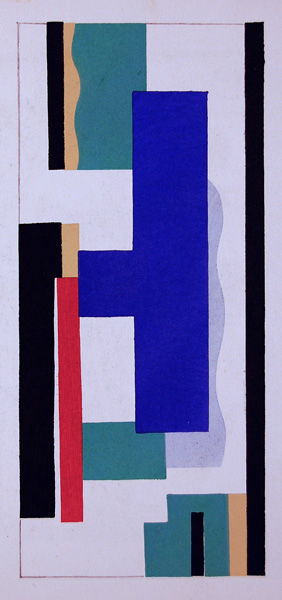 |
|
|
|
Peinture murale / Wall painting. Hand-painted pochoir after a gouache, c. 1924. This is one of 800 unsigned impressions for an important 1928 study of Léger by E. Teriade, who would soon become the editor and publisher of the most important Surrealist journal, Minotaur, and then Verve, one of the most beautiful art reviews ever published (Paris, 1928). The work appears to be related to a series of paintings (see Serotta, p. 23). Image size:223x100mm. Price: Please call or email for current pricing information.
|
|
|
|
|
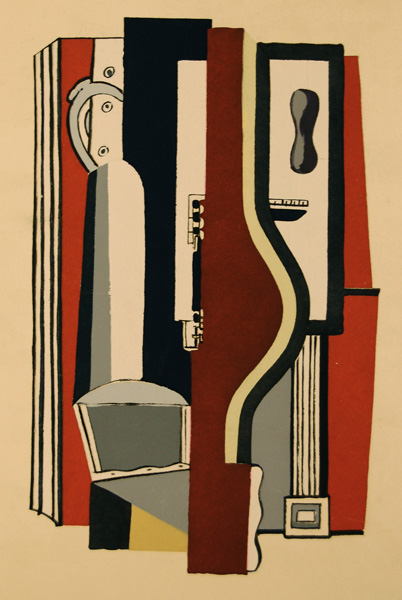 |
|
L'Accordéon / The Accordian. Hand-painted pochoir after a gouache, c. 1926. This is one of 800 unsigned impressions for an important 1928 study of Léger by E. Teriade, who would soon become the editor and publisher of the most important Surrealist journal, Minotaur, and then Verve, one of the most beautiful art reviews ever published (Paris, 1928). The work appears to be related to a painting of the same title (see Lanchner, pl. 211 and Pompidou, p. 150). Image size: 208x133mm. Price: Please call or email for current pricing information.
|
|
|
|
|
|
|
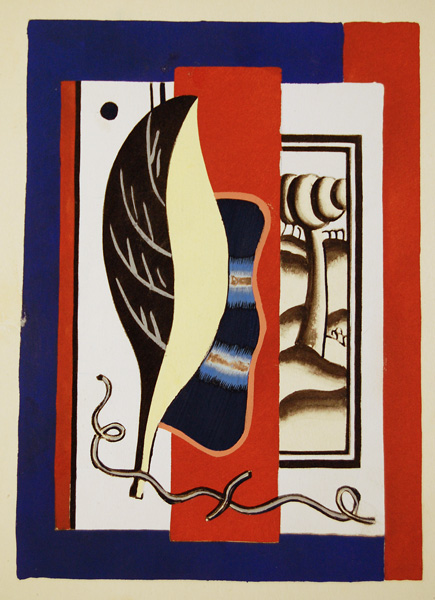 |
|
Composition à la feuille / Composition with a leaf. Hand-painted pochoir after a gouache, c. 1927. This is one of 800 unsigned impressions for an important 1928 study of Léger by E. Teriade, who would soon become the editor and publisher of the most important Surrealist journal, Minotaur, and then Verve, one of the most beautiful art reviews ever published (Paris, 1928). The work appears to be related to a painting of the same titled (see Neret, pl. 200). Image size: 216x166mm. Price: Please call or email for current pricing information.
|
|
|
|
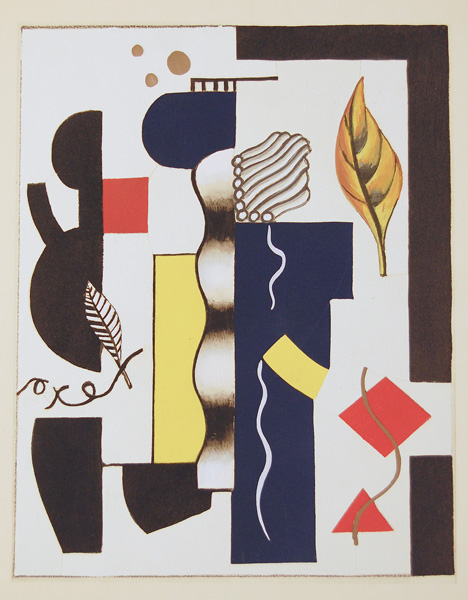 |
|
Nature morte / Still life. Hand-painted pochoir after a gouache, c. 1927. This is one of 800 unsigned impressions for an important 1928 study of Léger by E. Teriade, who would soon become the editor and publisher of the most important Surrealist journal, Minotaur, and then Verve, one of the most beautiful art reviews ever published (Paris, 1928). The work appears to be related to a painting of the same titled (see Pompidou, pl. 166). Image size: 210x164mm. Price: Please call or email for current pricing information.
|
|
|
|
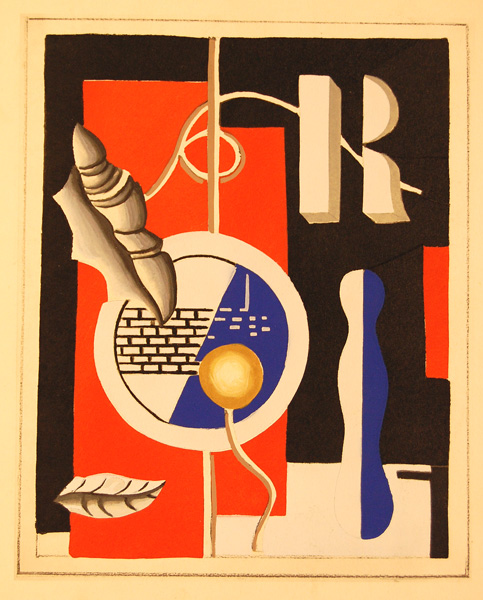 |
|
Coquille et feuille / Shell and Leaf. Hand-painted pochoir after a gouache, c. 1927. This is one of 800 unsigned impressions for an important 1928 study of Léger by E. Teriade, who would soon become the editor and publisher of the most important Surrealist journal, Minotaur, and then Verve, one of the most beautiful art reviews ever published (Paris, 1928). The work appears to be related to a painting of the same titled (see Neret, pl. 192 and Serotta, p. 27). Image size: 203x164mm. Price: Please call or email for current pricing information.
|
|
|
|
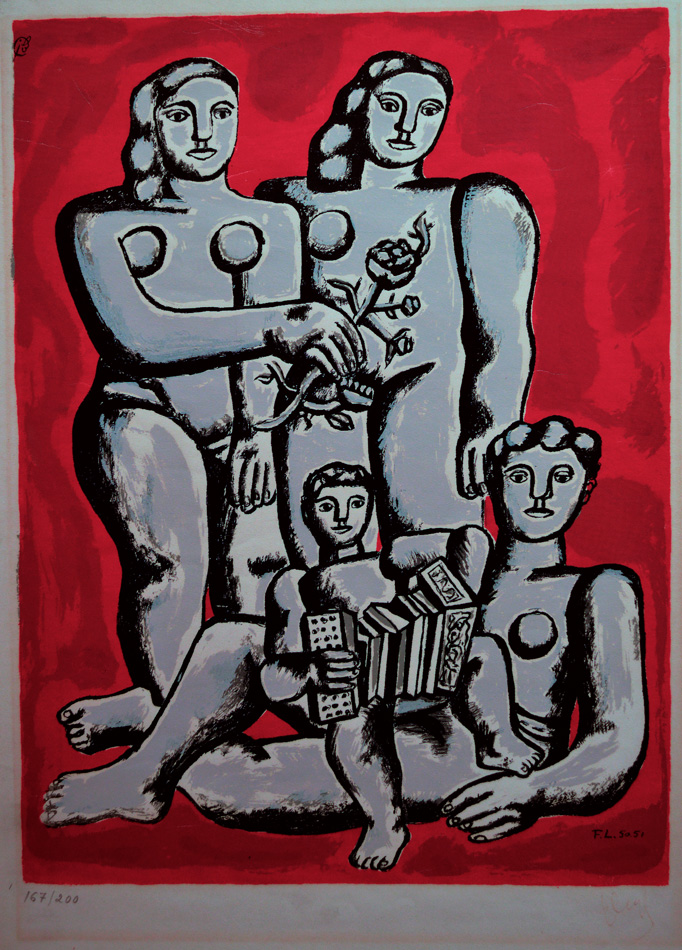 |
|
The three sisters on a red background (Sapphire E-11). Serigraph after a gouache, 1954. 200 signed and numbered impressions, of which ours is n. 167/200. There are also 1000 impressions signed and dated in the stone. Staining in margins; some cracking at top of image. This work is part of an album of 10 serigraphs after gouaches published by Jean Bruller in Paris and distributed in 1954-55 by La Guilde internationale de la Gravure (Geneva-Paris). One of Leger's most important late works in less than perfect condition. Image size: 453x338mm. Price: Please call or email for current pricing information.
The signature is in yellow ink (or brown ink that has faded): see below in the border bottom right below the printed signature
F.L.50.51"
|
|
|
|
|
|
|
|
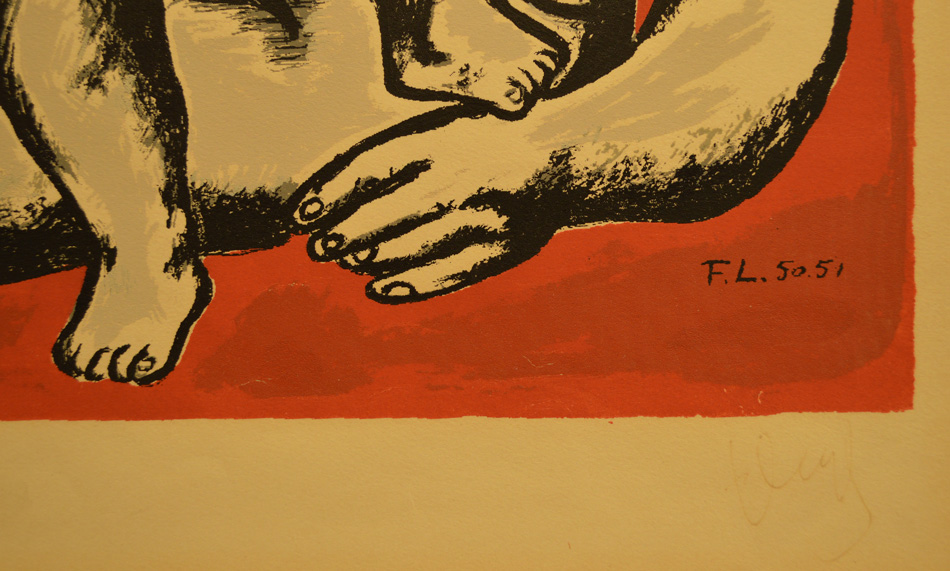 |
|
|
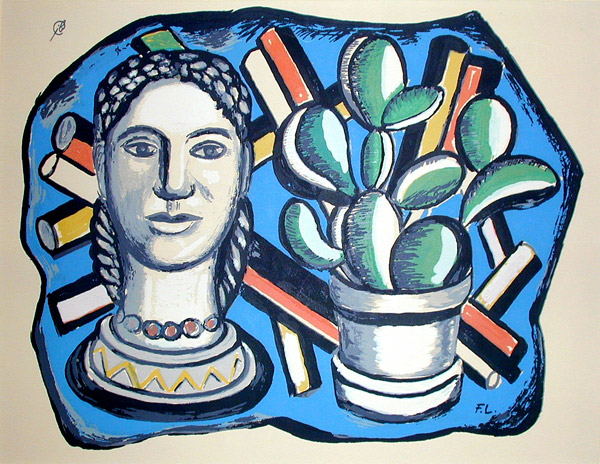 |
|
|
Compostion (Sapphire E-9) Serigraph after a gouache, 1954. 200 signed and numbered impressions plus 1000 impressions signed and dated in the stone, of which ours is one. This work is part of an album of 10 serigraphs after gouaches published by Jean Bruller in Paris and distributed in 1954-55 by La Guilde internationale de la Gravure (Geneva-Paris). Image size: 270x352mm. Price: Please call or email for current pricing information.
|
|
|
|
|
Spaightwood Galleries, Inc.
To purchase, call us at 1-800-809-3343 (1-508-529-2511 in Upton MA & vicinity) or send an email to spaightwood@gmail.com.
We accept AmericanExpress, DiscoverCard, MasterCard, and Visa.
We also accept wire transfers and paypal.
For directions and visiting information, please call. We are, of course, always available over the web and by telephone (see above for contact information). Click the following for links to past shows and artists. For a visual tour of the gallery, please click here. For information about Andy Weiner and Sonja Hansard-Weiner, please click here. For a list of special offers currently available, see Specials.
All works are sold with an unconditional guarantee of authenticity (as described in our website listing).
Copyright 2004-2017, Spaightwood Galleries, Inc.
Go back to the top of this page.
Visiting hours: Saturday 10:00 am to 5:00 pm and Sunday noon to 6:00 pm and other times by arrangement.
Please call to confirm your visit. Browsers and guests are welcome.
|
|
|
|
|
|
|
|
|
|
|
|
|
|
|
|
|
|
|
|
|
|
|
|
|
|
|
|
|
|







